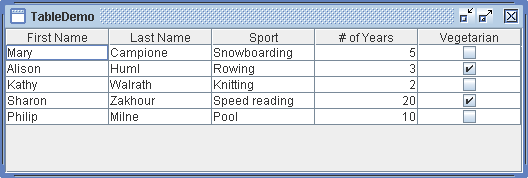Table with a custom TableModel

/* From http://java.sun.com/docs/books/tutorial/index.html */
/*
* Copyright (c) 2006 Sun Microsystems, Inc. All Rights Reserved.
*
* Redistribution and use in source and binary forms, with or without
* modification, are permitted provided that the following conditions are met:
*
* -Redistribution of source code must retain the above copyright notice, this
* list of conditions and the following disclaimer.
*
* -Redistribution in binary form must reproduce the above copyright notice,
* this list of conditions and the following disclaimer in the documentation
* and/or other materials provided with the distribution.
*
* Neither the name of Sun Microsystems, Inc. or the names of contributors may
* be used to endorse or promote products derived from this software without
* specific prior written permission.
*
* This software is provided "AS IS," without a warranty of any kind. ALL
* EXPRESS OR IMPLIED CONDITIONS, REPRESENTATIONS AND WARRANTIES, INCLUDING
* ANY IMPLIED WARRANTY OF MERCHANTABILITY, FITNESS FOR A PARTICULAR PURPOSE
* OR NON-INFRINGEMENT, ARE HEREBY EXCLUDED. SUN MIDROSYSTEMS, INC. ("SUN")
* AND ITS LICENSORS SHALL NOT BE LIABLE FOR ANY DAMAGES SUFFERED BY LICENSEE
* AS A RESULT OF USING, MODIFYING OR DISTRIBUTING THIS SOFTWARE OR ITS
* DERIVATIVES. IN NO EVENT WILL SUN OR ITS LICENSORS BE LIABLE FOR ANY LOST
* REVENUE, PROFIT OR DATA, OR FOR DIRECT, INDIRECT, SPECIAL, CONSEQUENTIAL,
* INCIDENTAL OR PUNITIVE DAMAGES, HOWEVER CAUSED AND REGARDLESS OF THE THEORY
* OF LIABILITY, ARISING OUT OF THE USE OF OR INABILITY TO USE THIS SOFTWARE,
* EVEN IF SUN HAS BEEN ADVISED OF THE POSSIBILITY OF SUCH DAMAGES.
*
* You acknowledge that this software is not designed, licensed or intended
* for use in the design, construction, operation or maintenance of any
* nuclear facility.
*/
/*
* TableDemo.java is a 1.4 application that requires no other files.
*/
import javax.swing.JFrame;
import javax.swing.JPanel;
import javax.swing.JScrollPane;
import javax.swing.JTable;
import javax.swing.table.AbstractTableModel;
import java.awt.Dimension;
import java.awt.GridLayout;
/**
* TableDemo is just like SimpleTableDemo, except that it uses a custom
* TableModel.
*/
public class TableDemo extends JPanel {
private boolean DEBUG = false;
public TableDemo() {
super(new GridLayout(1, 0));
JTable table = new JTable(new MyTableModel());
table.setPreferredScrollableViewportSize(new Dimension(500, 70));
//Create the scroll pane and add the table to it.
JScrollPane scrollPane = new JScrollPane(table);
//Add the scroll pane to this panel.
add(scrollPane);
}
class MyTableModel extends AbstractTableModel {
private String[] columnNames = { "First Name", "Last Name", "Sport",
"# of Years", "Vegetarian" };
private Object[][] data = {
{ "Mary", "Campione", "Snowboarding", new Integer(5),
new Boolean(false) },
{ "Alison", "Huml", "Rowing", new Integer(3), new Boolean(true) },
{ "Kathy", "Walrath", "Knitting", new Integer(2),
new Boolean(false) },
{ "Sharon", "Zakhour", "Speed reading", new Integer(20),
new Boolean(true) },
{ "Philip", "Milne", "Pool", new Integer(10),
new Boolean(false) } };
public int getColumnCount() {
return columnNames.length;
}
public int getRowCount() {
return data.length;
}
public String getColumnName(int col) {
return columnNames[col];
}
public Object getValueAt(int row, int col) {
return data[row][col];
}
/*
* JTable uses this method to determine the default renderer/ editor for
* each cell. If we didn't implement this method, then the last column
* would contain text ("true"/"false"), rather than a check box.
*/
public Class getColumnClass(int c) {
return getValueAt(0, c).getClass();
}
/*
* Don't need to implement this method unless your table's editable.
*/
public boolean isCellEditable(int row, int col) {
//Note that the data/cell address is constant,
//no matter where the cell appears onscreen.
if (col < 2) {
return false;
} else {
return true;
}
}
/*
* Don't need to implement this method unless your table's data can
* change.
*/
public void setValueAt(Object value, int row, int col) {
if (DEBUG) {
System.out.println("Setting value at " + row + "," + col
+ " to " + value + " (an instance of "
+ value.getClass() + ")");
}
data[row][col] = value;
fireTableCellUpdated(row, col);
if (DEBUG) {
System.out.println("New value of data:");
printDebugData();
}
}
private void printDebugData() {
int numRows = getRowCount();
int numCols = getColumnCount();
for (int i = 0; i < numRows; i++) {
System.out.print(" row " + i + ":");
for (int j = 0; j < numCols; j++) {
System.out.print(" " + data[i][j]);
}
System.out.println();
}
System.out.println("--------------------------");
}
}
/**
* Create the GUI and show it. For thread safety, this method should be
* invoked from the event-dispatching thread.
*/
private static void createAndShowGUI() {
//Make sure we have nice window decorations.
JFrame.setDefaultLookAndFeelDecorated(true);
//Create and set up the window.
JFrame frame = new JFrame("TableDemo");
frame.setDefaultCloseOperation(JFrame.EXIT_ON_CLOSE);
//Create and set up the content pane.
TableDemo newContentPane = new TableDemo();
newContentPane.setOpaque(true); //content panes must be opaque
frame.setContentPane(newContentPane);
//Display the window.
frame.pack();
frame.setVisible(true);
}
public static void main(String[] args) {
//Schedule a job for the event-dispatching thread:
//creating and showing this application's GUI.
javax.swing.SwingUtilities.invokeLater(new Runnable() {
public void run() {
createAndShowGUI();
}
});
}
}
Related examples in the same category